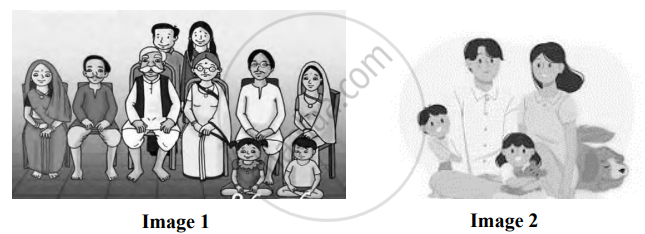Advertisements
Advertisements
Question
In what ways can changes in social structure lead to changes in the family structure?
Solution
The structure of family can be seen as social institution and also in its relationship to other social institution of society.
- The internal structure of the family is usually related to other structure of society i.e. political, economic, cultural, etc. Therefore any significant change in behaviour pattern of members of family may change the nature of society for example working schedules of young parents in the software industry in India may lead to increasing number of grandparents moving in as caregivers to the young grand children.
- The composition of the family and its structure thereby changes. And these changes can be understood in relation to other changes in society.
- The family (the private sphere) is linked to the economic, political, cultural and educational (the public) spheres.
- Sometimes the changes in the families and corresponding changes in the society occur accidently e.g. due to war or riots people migrate in search of work or for security reasons.
- Sometimes these changes are purposefully brought about, e.g. due to independence and openness of ideas, people choosing their jobs, life partner and life style and such changes are very frequent in the Indian society.
APPEARS IN
RELATED QUESTIONS
What are some of the different forms that the family can take?
Explain the difference between matriliny and matriarchy.
Answer briefly the following question :
What is an avuncupotestal family?
Briefly discuss any five types of families.
Discuss the structural and functional changes of the Indian joint family system.
Answer the following question briefly :
What is meant by globalisation?
Answer briefly the following question :
Mention any two features of a nuclear family.
Answer briefly the following question :
Examine the role of the family in human life.
Societies where women inherit property from their mothers are called ____________.
____________ is often grounded in stereotypes.
Among the Khasis, the family is:
| The present study…deals with a Muslim biradri (community) called the Multani Lohars. ... Karkhanedar is a vernacular term used for a person engaged in the business of manufacturing of which he is generally the owner…The karkhanas under study operate in domestic conditions and, therefore, have certain pervasive effects on the life of the karkhanedars who work in them. …The following case illustrates this. Mahmood, aged forty years, was living with his two younger brothers, one of whom was married. He had three children and was the head of the complex household. …All the three brothers were employed in various karkhanas and factories as skilled workers. Mahmood successfully fabricated replica of a motor part the import of which had been banned. This greatly encouraged him to start his own karkhana…Later it was decided that two karkhanas should be set up to manufacture the motor part. One was to be owned by the two elder brothers, and the other by the youngest, provided he set up a separate household. Rasheed set up an independent household, consisting of his wife and unmarried children. Therefore, one complex household, comprising three married brothers, gave birth to a simple household as a result of new entrepreneurial opportunities. Excerpted from S.M. Akram Rizvi, ‘Kinship and Industry among the Muslim Karkhanedars in Delhi’, in Imtiaz Ahmad, ed. Family, Kinship and Marriage among Muslims in India, New Delhi, Manohar, 1976, pp. 27- 48. |
As per the given passage, a complex household implies which of the following?
The matrilineal system has inherent disagreements based on ______.
In which of the following society, a newly married couple stays with the women's parents?
Traditionally, ______ were the business communities.
Herbert Spencer is the author of
Which among the following is based on direct co-operation?
What type of families are present among the Khasis?
The family is linked to the economic sphere. Highlight the link using any two scenarios.
“The structure of the family can be studied both as a social institution in itself and also in its relationship to other social institutions of society.” Elaborate.
Briefly explain the term joint family.
Discuss any five factors that have brought a change in this form of family.
State any one characteristic of the Conjugal family .

The two images shown above represent two family forms. Which one is characteristic of urban societies? Justify your answer with the help of six reasons.
Read the passage given below and answer the questions that follow.
|
I was born and raised in a large family in Ahmedabad where many members lived under the same roof. However, few months after I got married, my husband and I moved to Chennai. In the beginning, I enjoyed the privacy with my husband. But on certain occasions I also felt the absence of other family members around us along with their interactions and regular ‘interference’. As time passed by, I started feeling lonely and missed the crowd of relatives around me. I particularly remembered the fun-filled moments that I spent with my large family during festivals. My husband and I made good friends with few neighbours, but the loneliness remained. After the birth of both my children, I needed my mother and mother-in-law around to assist me for a while, but I had to manage on my own. Things became really difficult when I took up a job. I had to leave both my children in a day care centre. It was then that I most cherished the memories of my childhood spent with my family. |
- What types of family have been referred to by the narrator? (2)
- Compare the two types of families identified in subpart (i). (5)
